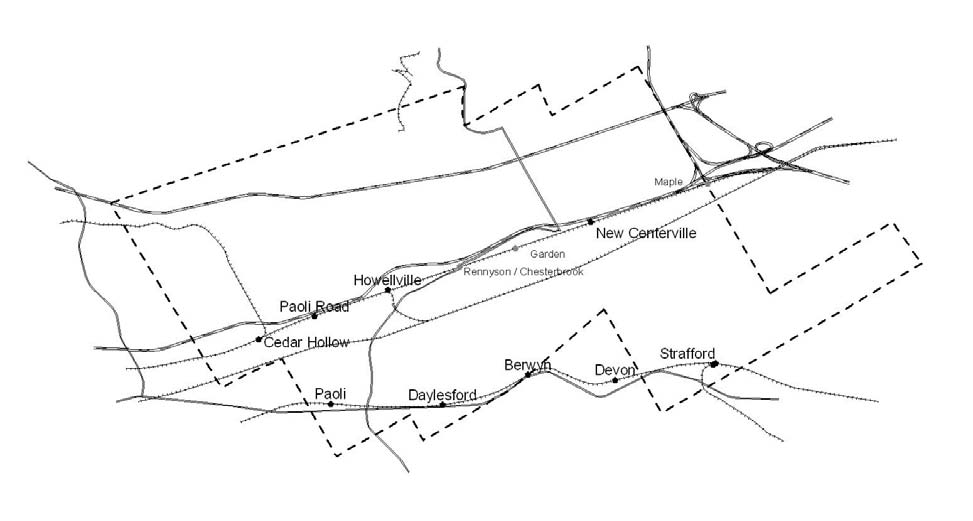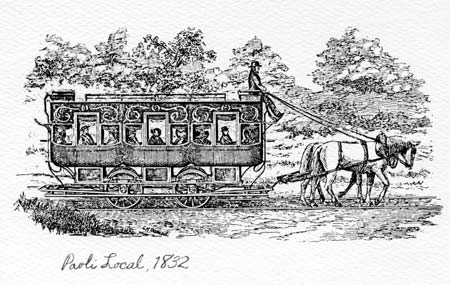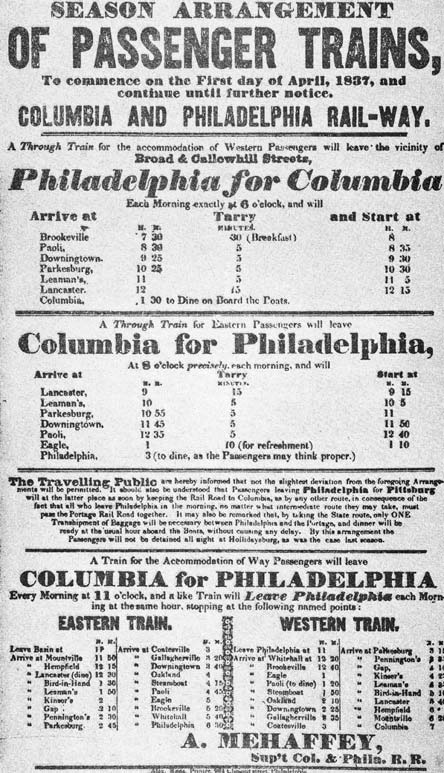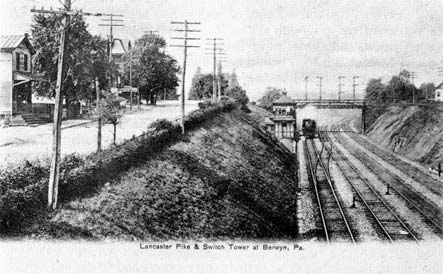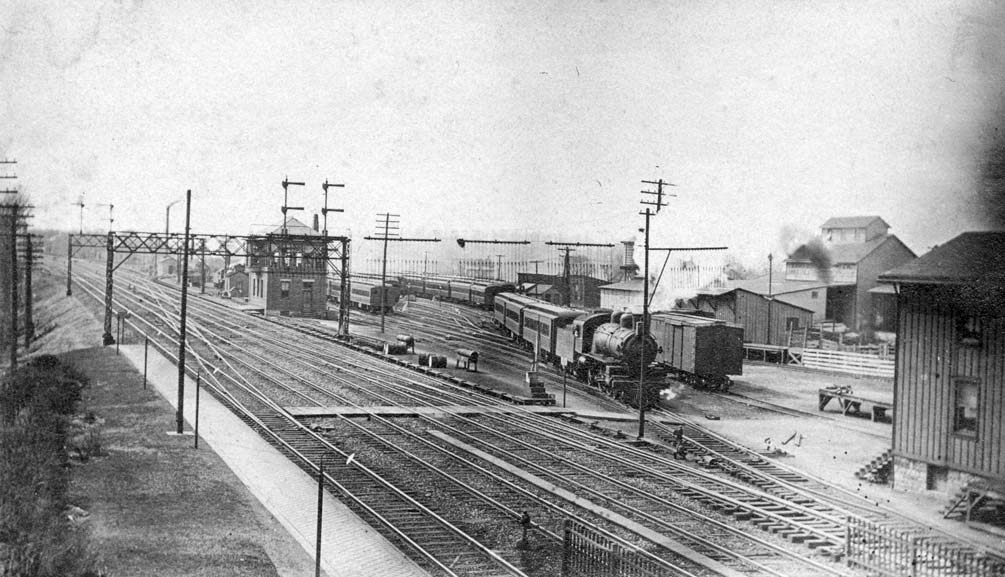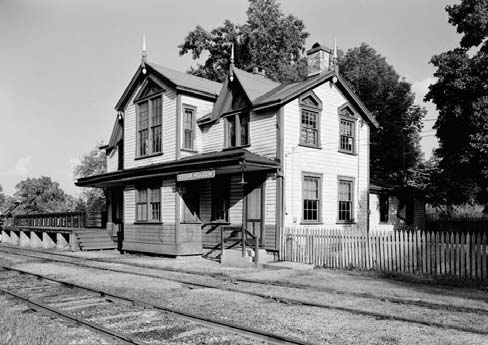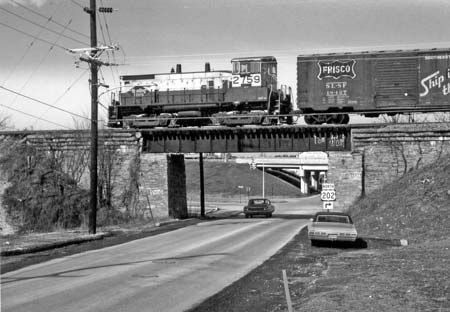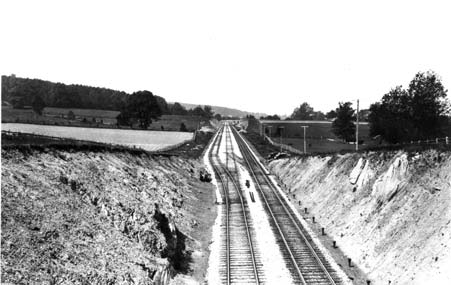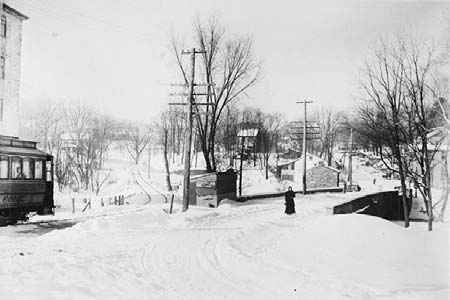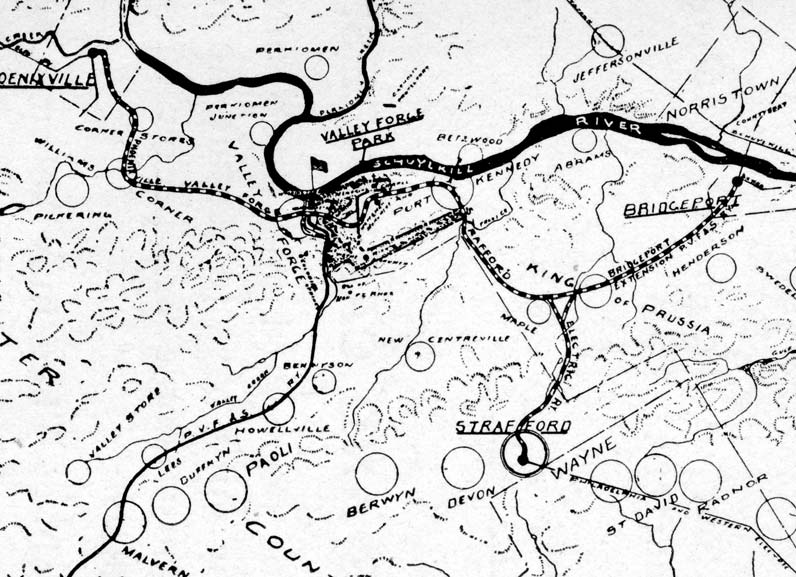|
Home : Quarterly Archives : Volume 44 |
Tredyffrin Easttown Historical Society |
|
Source: Winter/Spring 2007 Volume 44 Numbers 1&2, Pages 46–50 Railroads in Tredyffrin
Development The railroads in Tredyffrin run in an east-west alignment. The reason is twofold: the primary need was for through transportation that had Philadelphia as the eastern terminus and the Susquehanna Valley as the western. The secondary consideration was the terrain of the Great Valley. The Main Line The first railroad to be built through Tredyffrin and Chester County was the state-financed, owned and operated Columbia and Philadelphia Railroad. This line extended eventually from Broad and Vine Streets in Philadelphia to Columbia on the Susquehanna River, a distance of about 82 miles. The Pennsylvania Legislature charter for the C&P was approved in 1828. The line from Philadelphia to Malvern was open for public use by October 1832 and the extension to Columbia on April 16, 1834. Initially horses were used to pull the wagons. The charter of the Columbia & Philadelphia marked the third attempt to build a railroad between these two places. The previous two failed attempts, chartered in 1823 and 1826, were private attempts at financing and did not proceed to construction.
The Columbia & Philadelphia Railroad was the major rail segment of the Commonwealth of Pennsylvania's “Main Line of Public Works,” which also included the state-owned Pennsylvania Canal and the inclined-plane Portage Railway system up the Susquehanna and Juniata Rivers from Columbia, over the Allegheny Mountains to Pittsburgh. While the Columbia & Philadelphia was able to operate at a profit, eventually even including the bond interest on construction costs, the rest of the Main Line of Public Works did not. Nearly $18 million had been spent on the whole system's construction, and by 1842 debt had risen to an estimate of more than $30 million. Travel over the complete system was cumbersome and slow at best, with delays at each transfer between railroad and canal and inclined-plane railroad segments. From December to March, when the canals were frequently frozen over or damaged by floods, the canal and Allegheny Portage part of the Main Line of Public Works was shut down.
In 1846 The Pennsylvania Railroad Company was incorporated with the charter to build a new all-railroad system across the state from Harrisburg to Pittsburgh. By 1847, a sufficient number of shares of stock had been subscribed and the Pennsylvania Rail Road Company was officially organized on March 30, 1847. In March, 1853 the PRR obtained the right to operate its trains over the tracks of the Columbia & Philadelphia. Thus in February, 1854, upon completion of its track over the mountains, the Pennsylvania was able to run its trains all the way across the state between Philadelphia and Pittsburgh. The competition provided by the new all railroad system only aggravated the problems of the state's Main Line of Public Works. Within two months, in April of 1854, to rid itself of its unprofitable burden, the state tried unsuccessfully to sell the whole system for $20 million. But even when the price was lowered to half this amount the following year there were still no bids. It was finally purchased in June, 1857 by the PRR for $7.5 million plus a $1.5 million payment which would relieve the PRR thereafter of a state-imposed tonnage tax on its operations. The Columbia & Philadelphia Railroad Company was no longer a separate entity. But its existence for almost three decades as part of the state's Main Line of Public Works is still reflected in the use of the name “The Main Line” to describe this area. Its successor, the Pennsylvania Railroad Company, was to play a significant role in the development of Tredyffrin Township that continues to the present day.
Pennsylvania Railroad at Berwyn The stations in Tredyffrin proceeding westward on the former PRR (now SEPTA) Main Line in 2006 are Strafford, (but not Devon — that is in Easttown), Berwyn, Daylesford and Paoli.
Paoli Railyard, early 1900s The Chester Valley Railroad The second railroad to be built through Tredyffrin was the Chester Valley Railroad. It was planned originally in 1835 under the name of the Norristown & Valley Railroad and was intended to connect the Columbia & Philadelphia Railroad at Downingtown with the Philadelphia, Germantown & Norristown Railroad at either Conshohocken or, as it turned out, Bridgeport. The Chester Valley Railroad route from Bridgeport westward to Downingtown lay for most of this distance in the Great (or Chester) Valley, in contrast with the climb made by the Columbia & Philadelphia up the South Valley Hills ridge from Downingtown to the summit at Paoli. After several unsuccessful attempts at construction, including grading near Downingtown, the Chester Valley Railroad Company opened for public travel on September 12, 1853. The line came under the control of the Philadelphia & Reading on January 1, 1859 and was generally known as the Chester Valley Branch of the Reading.
Cedar Hollow Station The Chester Valley Railroad played an important although brief part in United States military history. When Lee's invasion of Pennsylvania was imminent in mid June 1863, the PRR requested and received permission from the Philadelphia & Reading for the temporary use of the entire 21.5 route miles of the Chester Valley, main track and sidings, to store their rolling stock so that it would not be destroyed by the Confederate forces. The defeat of the Confederates at the Battle of Gettysburg on July 1-3, 1863 settled that issue. In 1892, the stops on the Chester Valley Railroad were, moving from east to west: Maple (at County Line Road), New Centerville, Garden, Rennyson's (later Chesterbrook), Howellville, Paoli Road, and Cedar Hollow. At Cedar Hollow there was a branch line and a quarter mile-long siding that could hold thirty cars. The two mile-long Cedar Hollow Branch was constructed in 1855 by the proprietors of the Cedar Hollow Lime Company to connect with the Chester Valley at the Cedar Hollow Station. It ran north crossing Valley Creek and then west, just south of Yellow Springs Road to enter the limestone quarries at Cedar Hollow.
Train over Valley Ford Road, 1971 The last owner of the railroad was Conrail who abandoned the tracks in the late 1980s. The right of way of the Chester Valley Railroad is being developed as the Chester Valley Trail. The route of the spur to Cedar Hollow has also been designated for recreational trail development. The Trenton Cutoff The third railroad built through Tredyffrin was the Trenton Cutoff of the Pennsylvania Railroad. It extended eastward from the PRR Main Line at Glen Loch on the southwestern boundary of the township, on a low-grade route along the base of the South Valley Hills, between the PRR Main Line and the Chester Valley Railroad. The purpose of this freight-only line was to obtain a direct route to northern New Jersey and New York Harbor, avoiding the congested rail traffic around Philadelphia. Its construction began in 1889 and the line was opened in 1892. A spur line, the Howellville Branch, was constructed off the Trenton Cutoff just west of the Howellville Road bridge over the Trenton Cutoff. It proceeded down the slope in a northerly direction to the Howellville Quarries, which were also served by the Reading Chester Valley Branch.
Trenton Cutoff looking west from Cassatt Road bridge Since coming under Conrail control in 1976, the line has seen diminishing use and in 2006 only one freight a day runs regularly each way through Tredyffrin. In 2002, SEPTA published a plan and conducted hearings, including one at the Tredyffrin Township Building, to use the “Morrisville Line,” as it is now designated, for the projected “Cross-County Metro” commuter line. Philadelphia & Western Railway A fourth railroad, the interurban Philadelphia & Western Railway entered the township's southeast corner at Strafford and terminated there across Old Eagle School Road from the PRR Strafford station. In 1907 the P&W opened for business from the 69th and Market Streets Terminal in Upper Darby using third rail electrical power for commutation through the suburbs of Bryn Mawr, Villanova, and South Wayne to Strafford. This was before the PRR had electrified its Main Line from Philadelphia to Paoli in 1913-1915. In its construction, additional width was provided at all overhead bridges to allow for four tracks when a planned westward extension of this electric railway would be carried out to West Chester and Parkesburg, eventually joining with the Western Maryland Railroad at York, PA. Operations from Villanova Junction to Strafford were discontinued in 1956. The Radnor Recreational Trail uses this reclaimed right of way. Phoenixville, Valley Forge and Strafford Railroad This railway opened in 1912 and operated between Phoenixville and Valley Forge until December 24, 1923. It did not enter Tredyffrin, but the company had great plans for expansion. One proposed route was through Valley Forge Park to Port Kennedy and then south to Strafford. Another branch would have run up Valley Creek to Howellville then up the South Valley Hills to Malvern terminating in West Chester. Valley Forge Park effectively blocked the line's extension past Valley Forge village.
The terminus at Valley Forge of the Phoenixville, Valley Forge, & Strafford Railway Mount Misery Mineral Railway At the northeast corner of Tredyffrin on Mount Misery on the North Valley Hills, a narrow gauge Mineral Railway was built to transport the high purity silica deposits mined there. The line, which included two switchbacks, was constructed across and down the mountain's north face to a crushing plant and shipping point on the Reading Railroad at Valley Forge just west of Valley Creek.
Proposed routes of the Phoenixville, Valley Forge, & Strafford Railway |
| Previous Article ⇐ ⇒ Next Article |
